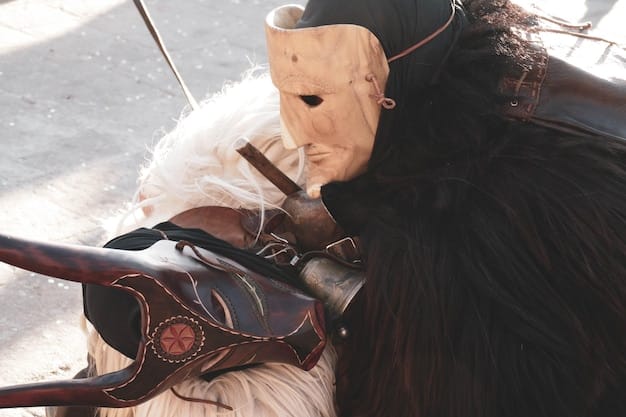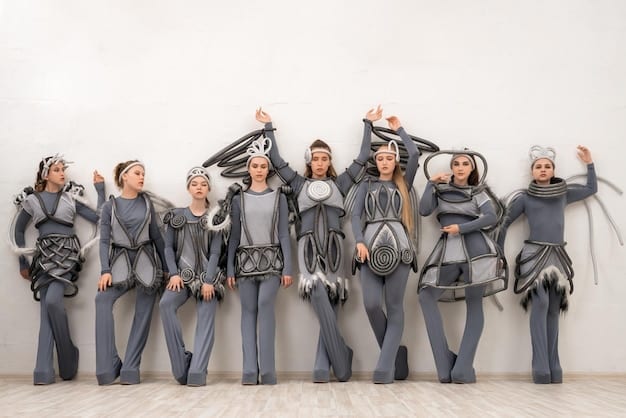The Ultimate Guide to Cosplay for Beginners

Cosplay, the art of dressing up as fictional characters, is a vibrant and engaging hobby. This guide provides a comprehensive introduction to cosplay, covering everything from selecting your first character to crafting costumes and attending conventions, suitable for beginners looking to dive into this creative world.
Ready to dive into the exciting world of cosplay? Cosplay, short for “costume play,” is a hobby where you dress up and embody a fictional character. Whether you’re a fan of comics, video games, anime, or movies, there’s a character waiting for you to bring them to life.
What is Cosplay and Why is it So Popular?
Cosplay is more than just wearing a costume; it’s about embodying a character, expressing your creativity, and connecting with others who share your interests. It’s a way to pay homage to the stories and characters that inspire us.
The popularity of cosplay stems from several factors, including the rise of fandom culture, the increasing accessibility of costume-making materials, and the sense of community it fosters.
The Rise of Fandom Culture
With the internet connecting fans from around the world, fandoms have become more organized and vibrant than ever before. Cosplay provides a tangible way for fans to express their love for their favorite characters and franchises.
Accessibility of Costume-Making
Thanks to online tutorials, affordable materials, and evolving crafting techniques, creating a cosplay costume is more accessible than ever. Beginners can start with simple projects and gradually build their skills.
Community and Connection
Cosplay events and conventions provide opportunities for cosplayers to meet, share their creations, and support each other. The sense of community is a significant draw for many participants.
- Expressing creativity and passion for characters.
- Connecting with like-minded individuals and building friendships.
- Developing crafting and performance skills.
- Experiencing the thrill of bringing a fictional character to life.
Cosplay offers a unique blend of creativity, craftsmanship, and community, making it a rewarding hobby for people of all ages and backgrounds. It’s a way to step outside of everyday life and into a world of fantasy and imagination.

Choosing Your First Cosplay Character
Selecting the right character for your first cosplay is crucial. It’s important to choose someone you love, but also someone whose costume is within your skill level and budget.
Consider these factors when making your decision:
Character Affinity
Select a character you genuinely admire and connect with. This will make the process more enjoyable and help you embody the character more convincingly.
Costume Complexity
Start with a costume that is relatively simple and achievable for a beginner. Avoid intricate designs, heavy armor, or complex props that may be overwhelming.
Budget Considerations
Costume materials, props, and accessories can add up quickly. Set a budget beforehand and choose a character whose costume aligns with your financial constraints.
- Research characters from your favorite fandoms.
- Browse cosplay photos online for inspiration.
- Consider characters with easily recognizable features.
- Prioritize comfort and mobility in your costume design.
Take your time and choose a character that excites you while being manageable for your first cosplay project. This will set you up for a positive and rewarding experience.
Sourcing or Creating Your Cosplay Costume
Once you’ve chosen your character, it’s time to decide whether to buy, commission, or create your costume. Each option has its own set of pros and cons.
Consider these factors when deciding how to acquire your costume:
Buying a Pre-Made Costume
Purchasing a pre-made costume is the easiest and fastest option. Many online retailers offer cosplay costumes for various characters. However, the quality and fit may vary.
Commissioning a Custom Costume
Commissioning a costume from a professional cosplayer or seamstress ensures a high-quality, custom-fit outfit. This option can be more expensive but guarantees attention to detail and accuracy.
Crafting Your Own Costume
Creating your own costume is the most challenging but also the most rewarding option. It allows you to express your creativity, develop crafting skills, and customize the costume to your exact specifications.
- Research reliable online retailers for pre-made costumes.
- Seek recommendations for reputable cosplay commissioners.
- Gather resources for costume-making techniques and tutorials.
- Experiment with different materials and crafting methods.
Regardless of your chosen method, research your options thoroughly, set a budget, and plan your timeline to ensure you have your costume ready for your first cosplay event.

Essential Materials and Tools for Cosplay
Crafting your own cosplay costume requires a variety of materials and tools. Having the right supplies on hand will make the process smoother and more enjoyable.
Here are some essential items to consider:
Fabrics and Textiles
Choose fabrics that are appropriate for your character’s costume design. Consider factors such as color, texture, weight, and durability. Common materials include cotton, polyester, spandex, and leather.
Foam and Armor-Making
EVA foam is a popular material for creating lightweight and durable armor pieces. It can be easily cut, shaped, and painted to achieve the desired look. Other options include worbla and sintra.
Tools for Sewing and Crafting
A sewing machine, scissors, needles, thread, pins, and measuring tape are essential for sewing costume pieces. Hot glue guns, craft knives, sanding blocks, and painting supplies are useful for working with foam and other materials.
* Fabric scissors and rotary cutters for precise fabric cutting.
* Heat guns and foam rollers for shaping foam pieces.
* Airbrush systems and acrylic paints for creating realistic finishes.
* 3D printers for producing custom props and accessories.
Invest in high-quality materials and tools to ensure your cosplay costume is both durable and visually appealing. Research different brands and techniques to find what works best for you.
Attending Cosplay Conventions and Events
Cosplay conventions and events provide the perfect opportunity to showcase your costumes, meet fellow cosplayers, and immerse yourself in fandom culture.
Preparing for your first convention:
Choosing Your First Convention
Research local and regional conventions that cater to your interests. Consider factors such as size, location, guest lineup, and event schedule. Smaller conventions may be less overwhelming for beginners.
Planning Your Convention Schedule
Review the convention schedule and identify panels, workshops, and meetups that you want to attend. Plan your day in advance to make the most of your time.
Cosplay Etiquette and Safety
Familiarize yourself with convention rules and guidelines regarding cosplay behavior and safety. Be respectful of other attendees, maintain awareness of your surroundings, and prioritize your well-being.
- Pre-register for the convention to save time and money.
- Pack a cosplay repair kit with essentials like glue, pins, and thread.
- Stay hydrated and nourished throughout the day.
- Take breaks and rest when needed to avoid burnout.
Attending a cosplay convention is an exciting and memorable experience. By planning ahead and prioritizing your comfort and safety, you can ensure a positive and rewarding first convention.
Improving Your Cosplay Skills Over Time
Cosplay is a journey of continuous learning and improvement. As you gain experience, you can refine your skills, experiment with new techniques, and create more ambitious costumes.
Focus on improving these elements:
Experimenting with New Techniques
Don’t be afraid to try new crafting methods, such as wig styling, prop fabrication, or special effects makeup. Online tutorials and workshops can provide valuable guidance and inspiration.
Seeking Feedback and Collaboration
Share your cosplay progress with fellow enthusiasts and ask for constructive criticism. Collaborating with other cosplayers can lead to valuable learning experiences and friendships.
Reflecting on Past Projects
Review your past costumes and identify areas for improvement. Reflect on what you learned from each project and apply those lessons to future endeavors.
- Attend workshops and seminars to learn from experienced cosplayers.
- Join online cosplay communities and forums to share your creations.
- Document your cosplay journey through photos and videos.
- Set realistic goals and celebrate your accomplishments along the way.
Cosplay is a hobby that rewards dedication and creativity. By continuously learning and refining your skills, you can create increasingly impressive and memorable costumes. Keep exploring, keep creating, and most importantly, keep having fun.
| Key Concept | Brief Description |
|---|---|
| 🎭 Choosing Characters | Select characters you love and whose costumes suit your skill level. |
| 🧵 Costume Creation | Decide whether to buy, commission, or craft your costume based on budget and skill. |
| 🛠️ Essential Tools | Gather fabrics, foam, sewing tools, and crafting supplies. |
| 🥳 Convention Prep | Plan your convention schedule, learn etiquette, and prioritize safety. |
Frequently Asked Questions About Cosplay
▼
Cosplay is short for “costume play,” a hobby that involves dressing up and embodying a fictional character from various forms of media, such as anime, video games, and comics.
▼
Select a character you love and whose costume complexity matches your skill level. Start with simpler designs to avoid being overwhelmed. Consider your budget and available time as well.
▼
You can buy cosplay costumes from online retailers specializing in cosplay, such as Amazon, eBay, and dedicated cosplay websites. Also consider local costume shops or commissions from professional cosplayers.
▼
Cosplayers often use materials like fabric, EVA foam (for armor), worbla, and various crafting supplies. The choice of materials depends on the specific costume and desired level of detail.
▼
To improve your cosplay skills, practice regularly, experiment with new techniques (like wig styling or prop making), and seek feedback from experienced cosplayers. Attend workshops and join cosplay communities.
Conclusion
Embarking on your cosplay journey can be incredibly rewarding. By starting with a well-loved character, planning carefully, and continually refining your techniques, you can create stunning costumes, connect with fellow enthusiasts, and immerse yourself in the vibrant world of cosplay.





